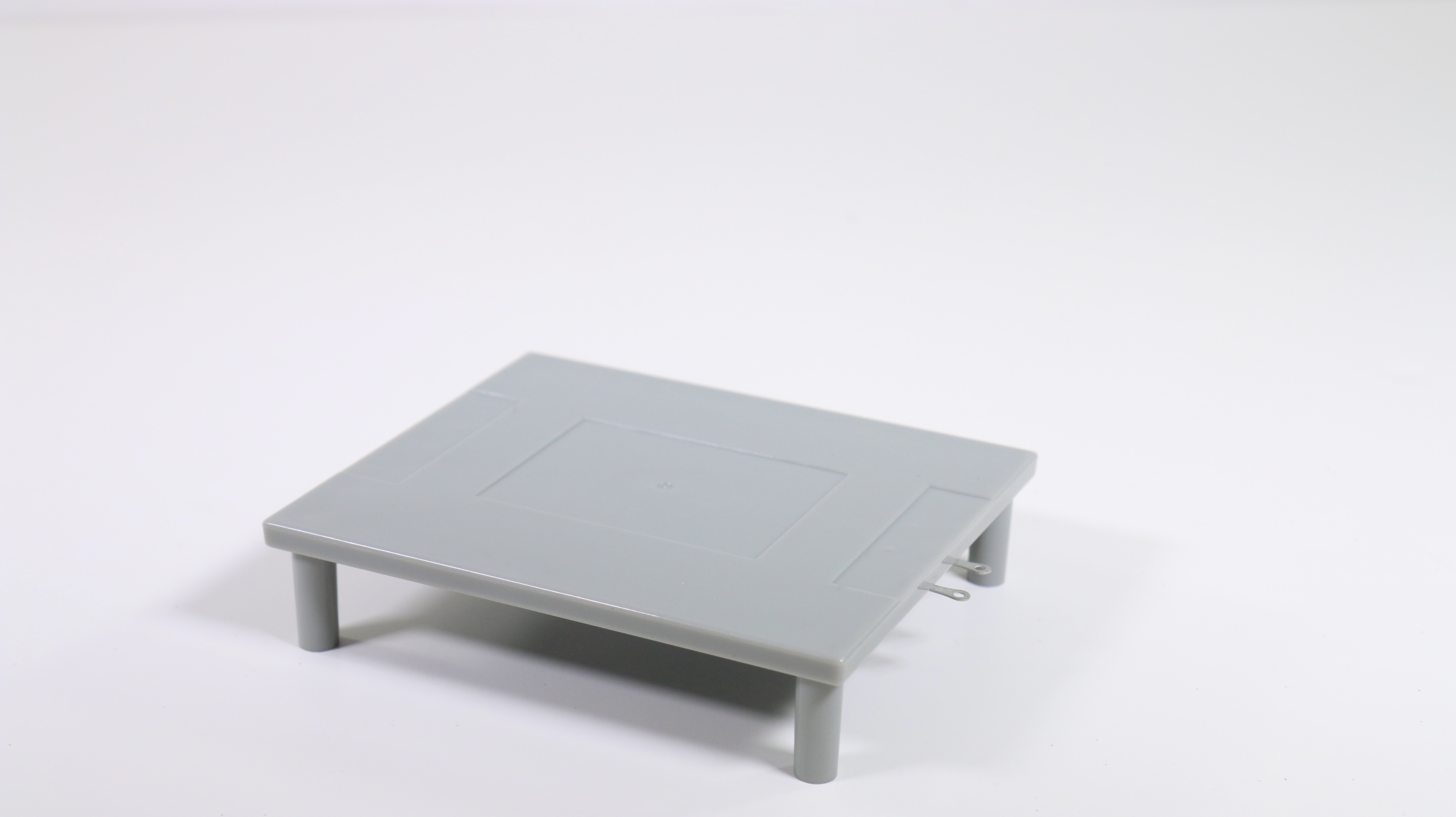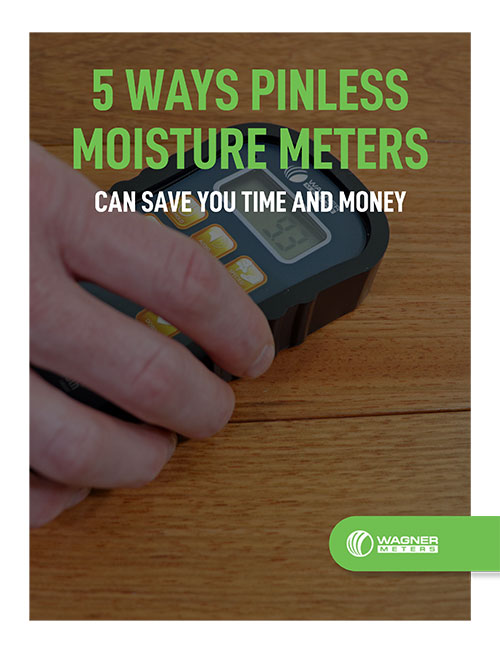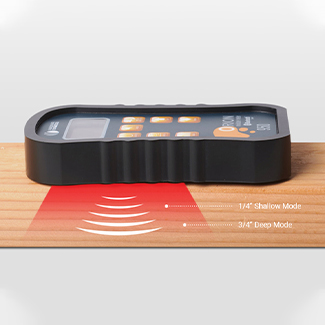Electromagnetic Wave Technology Use in Moisture Meters
How Does an Orion Moisture Meter Work?
Wagner Meters uses an advanced electromagnetic wave technology in its hand-held moisture meters. This proven technology allows the user to quickly and accurately measure the moisture content (MC) of wood without the time-consuming effort of driving pins into the wood. The meters from Wagner Meters provide instant readings, allowing you to scan many board feet in seconds. Electromagnetic radio waves are sent into the wood without leaving any holes.
What Is IntelliSense™ Technology?
Wagner moisture meters, featuring IntelliSense™ technology, go beyond the surface conditions for accurate measurements of moisture conditions IN the wood. Most pinless meters are unable to distinguish between the surface or ambient conditions on the surface of the wood, and the real moisture picture in the wood. Pin-type meters may be able to bypass the surface conditions, but they also damage the surface of the wood each time you take a reading. Air humidity, condensation, or other ambient conditions can impact many moisture meters and give inaccurate readings that cost you money.
Here is a short video about how IntelliSense technology works:
Pin-Type Meters vs. Electromagnetic Wave – Why Do They Read Different?
Pin-type moisture meters work on a resistance principle that basically measures the flow of electricity through a substance. This method is subject to many environmental variables that can dramatically affect moisture meter readings such as chemicals in the water trapped within the wood and the temperature of the wood. Most pin-type meter readings must be corrected for any difference in temperature above or below 70 degrees F.
The Orion® line of pinless hand-held wood moisture meters are virtually unaffected by the temperature of the wood. Wagner Meters incorporates IntelliSense technology in all of our deep depth wood moisture meters to ensure that the effect of surface moisture on the wood moisture reading is minimized.
Safe to Use
Moisture meters by Wagner Meters produce less electromagnetic radiation than standard house wiring. In addition, Wagner moisture meters have tested and certified their meters to comply with FCC and CE regulations.
Moisture Meter Accuracy
ASTM D4442-92 Oven Dry – this is the standard to which all wood moisture meters are compared for accuracy.
A moisture meter from Wagner Meters is as accurate, or more accurate than any moisture meter that is on the market. This can be verified by several university meter studies found here. Studies which may refer to another model, relate to all of our wood moisture meters because they have the same circuitry, technology, and accuracy.
Wagner Meters Usage Tips
Be sure to press down firmly on the center of the moisture meter with approximately 3 pounds of pressure to ensure good sensor plate contact with the wood surface. This is especially important on rough-sawn lumber. Do not take readings with the meter where there is a noticeable defect or knot in the lumber.
If there is visible surface moisture or water, wipe off any excess, and let the surface of the wood dry-out for a couple of minutes. Next, use the moisture meter to take the reading. If possible, turn the board over and use the meter to measure the other side. If the thickness of the piece is greater than 1-1/2 inches, it is a good idea to use the meter to take measurements on both sides.
Ensure that there is nothing (especially your hand or metal) under the material you are measuring. In order to take a valid measurement, the meter’s sensing area must be completely covered with the wood you are measuring. If the meter’s sensing area is not completely covered, your MC reading may be lower.
Wood Temperature or Surface Moisture
Moisture meters by Wagner Meters are virtually unaffected by wood temperature.
Standing water or visible water on the board can affect the reading. Visible water should be wiped off.
NOTE: If water is allowed to soak into the wood, it will naturally show higher MC. If a piece of wood is quite rough, it will soak up the water quite readily, affecting the readings for all moisture meters.
Ruggedness
Wagner Meters’ hand-held moisture meters are designed for compact convenience. They are not easily damaged, but they can be damaged by being dropped or slammed down on hard surfaces, as can any moisture meter. For large volumes of wood, an in-line moisture measurement system should be used.
Verifying Calibration
 Wagner Meters calibrates their moisture meters at the factory. With proper care, the meters stay in calibration. In the event that the moisture meter has been dropped, or you suspect for any reason that the meter is out of calibration, and you have an Orion moisture meter, perform a meter calibration. With the Orion moisture meter, it can be calibrated on the spot so long as the included On-Demand Calibrator is available. If you have a legacy meter and cannot do field calibrations, a calibration verification block can be purchased online. If the meter is not reading correctly on the calibration block, it should be sent to the factory for calibration.
Wagner Meters calibrates their moisture meters at the factory. With proper care, the meters stay in calibration. In the event that the moisture meter has been dropped, or you suspect for any reason that the meter is out of calibration, and you have an Orion moisture meter, perform a meter calibration. With the Orion moisture meter, it can be calibrated on the spot so long as the included On-Demand Calibrator is available. If you have a legacy meter and cannot do field calibrations, a calibration verification block can be purchased online. If the meter is not reading correctly on the calibration block, it should be sent to the factory for calibration.
Sensing Area
Narrowest Measurement
Orion moisture meters can measure wood that is within their sensor width of 1-1/2 inches.
Depth of Measurement
The Orion 910 takes moisture readings in your wood or other material from the surface down to .75” (19mm) in depth. The Orion 920 is designed exclusively for shallow measurement of MC from the surface down to .25” (6.4mm) deep inside wood or other material. The Orion 930, 940, and 950 are designed for measurement of MC from the surface down to .25” (6.4mm) or .75” (19mm) deep inside wood or other material depending on the deep or shallow measurement mode to which the meter is set.
If you wish to measure wood pieces with thicknesses less than .75” (19mm) in deep measurement mode, the meter will underestimate the actual MC by some amount. Thicknesses that are slightly thinner (example: .625” (15.9mm)) will not be underestimated substantially, but the thinner the piece becomes, the more the measurement will be underestimated. For pieces thinner than .50” (12.7mm), it is recommended that you use the shallow mode.
Correct MC
The correct MC varies from region to region and indoor or outdoor use. Refer to local builders or associations for the appropriate range in your area. If the wood is to be glued and is too dry, it won’t bond; if too wet, it won’t hold.
Resources for determining the proper MC:
- University Forestry Departments
- Industry Associations
Forest Products Research Laboratory in Madison, WI, (608) 231-9200
Frozen Wood
On frozen wood with up to 15% MC, accurate measurements can be obtained. For frozen wood with more than 15% MC, contact technical support for help.
Wet pockets and gradients continually equalize as moisture passes from fiber to fiber and to surrounding humidity levels. Moisture meters measure the average of the area scanned. Meters can be held in one place or slid along the length of the wood.

Free Download – 5 Ways Pinless Moisture Meters Save You Time and Money
Specific Gravity References
First refer to the Species Settings booklet that came with your wood moisture meter. If you are unable to find the specific gravity (SG) in those documents, click here.
Measuring Non-Solid Wood
Wagner Meters has developed meter correction factors for the following non-solid wood products. The information is available inside the Species Settings booklet. This gives a relative reading because of the glues and resins.
- Plywood
- OSB
Wood Treatment Notes
CCA (1% CCA, 99% water)
- Copper – Basis for killing insects
- Chromium – Helps copper travel & permeate wood cells
- Arsenic – Gels copper into wood so it will not leach out
ACQ Environmentally safer than CCA
- Copper- Basis for killing insects
- Ammoniacal – Ammonia/salt-based – Helps copper travel and permeate wood cells
- Quaternary – Gels copper into wood so it will not leach out
Both CCA & ACQ will cause readings on the meter to be higher.
The process for treating wood is: Soak wood in pressure chambers and then use a vacuum to pull out excess fluid. MC is 30 – 40% after treatment. The wood is then put on drip pads for 2 – 3 days and then kiln dried to their MC specification.
OVEN DRY TEST MUST BE DONE ON ANY TREATED WOOD.
View Our Orion Moisture Meters
Wagner Meters is a family-owned American business that aims to provide solutions in moisture measurement technology that will enhance the quality and value of each customer’s project. With an almost 60-year legacy of innovation, Wagner continues to be a resource for both individual craftsmen and high-performance commercial endeavors.
Related Posts via Taxonomies
Last updated on June 29th, 2022





As far as I understand capacitance wood moisture meters are suitable only for perfectly smoth surfaces, and usually used for finished and kiln dryed wood products.
What about these instruments? How useful are they for rough surfaces and high moisture content (not kiln dryed)? I need to measure moisture content in pallets. Do you have scientific research that proves adequacy?
Silvia,
Wagner handheld moisture meters have been used on rough-sawn lumber; a little more pressure needs to be applied. Additionally, neither non-pin (e.g., capacitance) nor pin-type meters should be used where there is a visible knot or defect.
Next, no type of moisture meter is very accurate on wood when the moisture content increases above 30% moisture content.
Wagner has studies showing the accuracy of its moisture meters in moisture content ranges below 30% moisture content.
Where can I gain access to the university meter studies mentioned in the article?
James,
The studies can be found here: https://www.wagnermeters.com/moisture-meters/wood-moisture-training/moisture-meter-accuracy-studies/
Hi – I have a question. Will your moisture meters work with pressure treated fire retardant material? If not, do you know what kind of meter would work and who offers it. Thanks
Barry, yes, the meters will work, but the correct ‘product’ setting may have to be determined by some lab testing. Hoover Treated Wood https://www.frtw.com/?q=about, one of the bigger producers of fire-retardant treated plywood and lumber is a long-time Wagner customer. A study done by them back in 1996, helped them determine the correct correction factor or meter setting to produce the most accurate meter measurements versus the ASTM oven-dry laboratory test.
In short, the meters can provide reliable results with the correct setting.